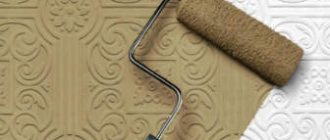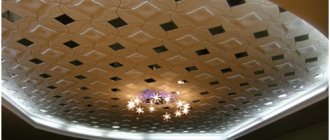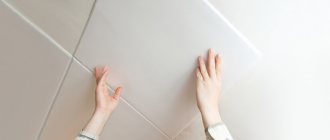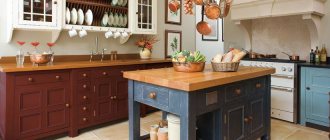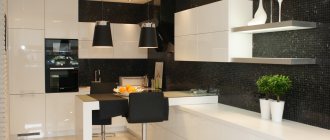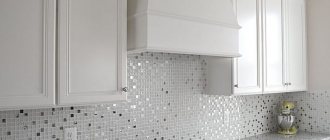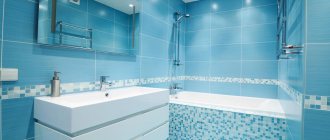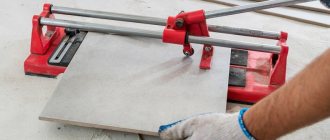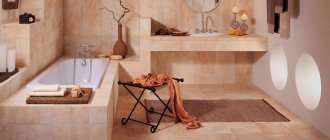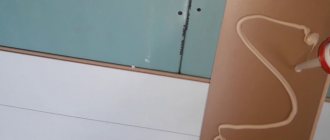Ceiling tiles - affordable material
Ceiling tiles are a great way to finish your kitchen ceiling quickly and inexpensively. In order to ultimately get a truly high-quality result, you must first become familiar with some of the nuances of such finishing. Therefore, we suggest that you familiarize yourself in detail with how ceiling tiles for the kitchen are selected and installed.
No. 1. What is ceiling polystyrene foam?
Decorative tiles are made from polystyrene, which foams when heated. During production, fire retardants and carbon dioxide , substances that increase resistance to high temperatures. Expanded polystyrene tiles made in this way, although they melt under the influence of fire, still perform better than ordinary polystyrene foam. By the way, you can also find foam ceiling tiles on sale: they are not only less safe, but also rougher in appearance. The presence of fire retardants in the composition of the boards is indicated by the marking : domestic manufacturers add the letter C, foreign manufacturers – F.
The material may vary greatly in size, shape, color and appearance. On sale you can find tiles in square, rectangular and designer shapes. The surface can imitate decorative plaster in a country style or exquisite stucco in the Baroque style. The classic color of the tile is white, but colored versions and products with a mirror and laminated surface are also sold. Standard sizes are 50*50 and 100*16.5 cm, but other formats are also available.
Cassette ceiling (decorative panels)
The cassette ceiling is known to many office workers (white square modules decorate almost any office). Technologies now make it possible to produce modules not only from white plastic, but also glass, “mosaic-like”, with various patterns, textures and a wide variety of colors.
The modules are mounted on a special frame, so processing of the base ceiling is not required.
The kitchen is an independent room with its own specific functionality. The ceiling in the kitchen should be durable, but at the same time meet modern trends in design. The choice of color and texture depends only on the budget and style of the entire room.
No. 2. Advantages and disadvantages
Expanded polystyrene ceiling tiles are among the most popular finishing materials. Buyers appreciate it for its numerous advantages :
- affordable price . In this regard, tiles can become a competitor even to ordinary painting. The most expensive samples with an exquisite design, which do not allow you to determine at first glance what the ceiling is made of, will cost much less than, for example, a system of suspended or suspended ceilings;
- ease of installation . You can cope with gluing ceiling tiles on your own, without any special skills. Considering the low price of the material, it can be called an ideal choice if the budget for repairs is limited;
- big variety . On sale you can find both the simplest white tiles with a simple pattern, and materials that very accurately replicate the structure of wood or stone, so you can use ceiling tiles to decorate any interior. White tiles can be painted in any desired shade;
- additional heat and sound insulation premises;
- resistance to temperature changes and high humidity, so the tiles can even be used in the bathroom;
- tiles do not steal height, unlike stretch and suspended ceilings. Additionally, it hides small irregularities and cracks that would definitely have to be removed when painting;
- expanded polystyrene - although an unnatural material, it does not pose any particular danger. It does not emit harmful substances under normal operating conditions, unless, of course, it is made with high quality and has all safety certificates. Tiles become dangerous at high temperatures, i.e. during a fire;
- The material is easy to care for; it can be cleaned with a vacuum cleaner or a damp sponge;
- high maintainability. If part of the ceiling is damaged, then several old elements can easily be replaced with new ones, so always take tiles with a reserve.
Now about the disadvantages :
- low durability and the ability to turn yellow over time, and the process accelerates if direct sunlight constantly falls on the surface;
- tiles are easily damaged by tobacco smoke, grease and soot, so they are not recommended for use in the kitchen;
- constant temperature changes can lead to some elements falling off, but this is only if low-quality glue was chosen for installation;
- expanded polystyrene is a fairly delicate material, so you should be careful when transporting and installing it;
- expanded polystyrene tiles are not very resistant to fire, and even when impregnated with fire retardants, they can ignite, releasing toxic substances. To be on the safe side, it is better not to place the lamp very close to the ceiling. Such precautions will also prevent yellow spots from the lamp from appearing on the material;
- When cleaning the surface, you should be extremely careful - a too wet sponge or using a rough brush can cause the tiles to peel off.
Experts convince us that truly high-quality ceiling tiles, thanks to the additives used, do not turn yellow for a long time and almost do not support combustion. Conscientious manufacturers declare that all the myths that exist among people are caused by the abundance of low-quality products on the shelf, and they advise you to always ask for a certificate of conformity. Sometimes we ourselves are to blame for the fact that the experience of using polystyrene foam turns out to be negative. It’s not just about choosing low-quality tiles, but also about choosing the wrong adhesive, on which a lot also depends.
Expanded polystyrene ceiling tiles can be used in almost any room. It is undesirable to just glue it in the kitchen, and you can still find other material for the nursery.
Whitewashing, painting, wallpaper
Whitewashing and painting the ceiling remain the most budget-friendly ways to update the ceiling. However, before painting or applying wallpaper, the ceiling must be carefully leveled. The paint can be either matte or metallic, glossy or almost mirror-like.
Wallpaper is also selected depending on the project: Matte, shiny, photo wallpaper, with a 3-D effect, which allows you to visually “raise” the ceiling in the kitchen.
No. 3. Main types of polystyrene foam tiles
According to the type of production, ceiling polystyrene foam can be of the following types:
- stamped or pressed;
- extruded;
- injection.
Stamped boards are produced by placing polystyrene foam blocks into special molds and then compressing them. The result is products with the simplest and not very relief patterns, small thickness (about 6-8 mm) and very fragile. Since such slabs are not covered with a protective layer, they absorb dirt well and are difficult to clean. The main advantage is the price.
Extruded panels are considered the most durable, durable, reliable and moisture resistant. The material is produced by hot extrusion of strips of raw materials. The result is tiles with a slight grain size and an almost smooth, dense surface, making it possible to apply a decorative coating. Such panels can be simply white and have complex patterns, or they can imitate the surface of any type of wood or stone. Due to high density, minimal porosity and impregnation with water-repellent compounds, the material obtains sufficient resistance to moisture. It is extruded tiles that can be seamless, which we will discuss below.
Injection polystyrene foam is produced by filling raw materials into a mold and sintering it under high temperatures. The result is a product with precise geometry and a clear relief pattern, the thickness of the slabs is 9-14 mm. Such panels tolerate moisture well, retain noise and heat well, are quite durable and come in a wide variety of patterns. Due to their intricate ornamentation and good performance qualities, such slabs are sometimes even used for wall decoration. Often injection panels are produced with imitation leather, wood, fabric, and ceramics.
The right way
- We strip the whitewash and plaster down to concrete. It is permissible to leave only that part of the plaster that holds VERY firmly. We use a steel spatula or perforator as a tool.
- We carry out treatment against mold and mildew. The ideal option is a special antiseptic primer, but an aqueous solution of any chlorine-containing preparation (for example, domestic Whiteness) will also work.
- We prime the ceiling with a penetrating primer. We apply it not with a roller, but with a brush - this way it will better penetrate into surface unevenness.
- We fill large irregularities with any gypsum putty; After it dries, we again prime those areas that were puttied.
- And only after that we glue the tiles with any universal glue. The procedure for gluing the tiles is the same as in the first case.
We start gluing the tiles from the corner we look at most often.
No. 4. Surface type
In terms of variety, polystyrene foam ceiling tiles outshine many other finishing materials. Based on surface type, the entire range presented can be divided into the following types:
- ordinary white tiles , which, if desired, can be painted in any suitable shade;
- plain colored tiles;
- laminated tiles. Due to the thin film that is applied on top of polystyrene foam, you can imitate any type of wood, stone and other noble materials. The film allows you to make the tiles more resistant to moisture and dirt, as well as simplify the process of cleaning them;
- Mirror tiles are distinguished by the presence of a thin mirror layer. Such products are exclusive design options and are great for decorating small spaces, as they will visually expand the space. The only exception is the bedroom, where a mirrored ceiling is inappropriate.
The shape of the tile can be square, rectangular, diamond-shaped, there are also irregular tiles, the so-called. designer form.
Distinctive features of the material
This renovation is considered an ideal option for a kitchen with low ceilings. As a result, valuable centimeters of space will not be “eaten up”, and the surface will be neat and solid. Therefore, such coatings are often used for finishing Khrushchev buildings.
Advantages of tiles:
- low cost;
- ease of installation;
- protection from external aggressive factors;
- removal of moisture, preventing the growth of fungus;
- painting the surface in any color;
- getting rid of minor defects in the base base;
- does not require special care conditions.
Recommendation! High air humidity serves as the basis for finishing the ceiling with special laminated tiles that imitate any natural surface of the material.
This coating is clearly shown in the photo.
No. 5. Seamless ceiling tiles
Seamless tiles are worth highlighting separately. Many people are confused by the fact that seams are formed during installation. If you glue regular tiles and act carefully, they will be almost invisible, but if you are a perfectionist who wants to get a monolithic surface, then you will like seamless tiles.
The main feature of the material is the special processing of the edges, due to which the seams will be minimally noticeable. As a rule, the manufacturer provides an installation diagram on the packaging, and if you follow it exactly, you can get an ideal, complete ceiling surface.
Fast way
- Using a steel spatula, we remove the peeling plaster and whitewash where it adheres especially poorly.
- We dilute PVA glue with water in a 1:1 ratio.
- We prime the surface of the ceiling with it directly on top of the whitewash or water-based paint.
Primer is a mandatory step.
Please note: if the ceiling was painted with any enamel that has begun to peel off, it is better not to try to save time and remove the paint completely. It is GUARANTEED to continue to peel off, along with the tile.
- Using the same PVA, after the primer has dried, we glue the tiles. We start laying it from the corner of the ceiling, which is located directly opposite the entrance: this is where the eye first stops, and this is where it is very important to make the tile line parallel to the wall.
- If the kitchen walls are not parallel and the corners have noticeable deviations from 90 degrees, it is better to glue the tiles diagonally. There will be slightly more waste, but visually the ceiling will look much more attractive. In this case, it is better to start gluing the tiles from the center and move towards the walls.
Sometimes it is more convenient to glue the tiles diagonally and start from the center. Most often it becomes a chandelier.
No. 6. What else to consider when choosing?
When choosing expanded polystyrene tiles, it is very important to personally see and evaluate the quality of the material:
- The edges of the tiles should be smooth and not crumble. If you choose square or rectangular tiles, then the corners should be clearly straight;
- all grains of the tile must be the same;
- all tiles must be the same size, because discrepancies of a few millimeters will no longer allow for good joining of elements and surface integrity;
- Quality tiles must be strong enough to support their weight. This is easy to check. You should take the tile by one corner: this operation should not lead to cracks.
The tile can be of shape and size The most popular are square tiles measuring 50*50 cm, 30*30 cm and rectangular tiles 100*16.5 cm. to calculate the required amount of material . First of all, you need to know the area of the surface to be finished. It should be divided by the area of the material in the package. For example, if you take a large square tile, then there are usually 8 pieces or 2 m2 in a package. If the ceiling area is 17 m2, then it’s worth taking 9 packages, 10-11 is better: a small supply will not be superfluous, it will be useful during repairs, especially since during installation and trimming some of the tiles may be damaged. It is better to take a stock of material of 15-20%.
Cellular ceilings
Unusual ceilings with a cellular structure are classified as suspended ceilings.
Waffle pattern is divided into:
- Mirror.
- Color.
- Metallized.
Air passes through the hanging modules perfectly, which is important for the kitchen. The material does not rust and will last a long time, but at the same time the base ceiling is visible through the cells, which first needs finishing.
No. 7. The best manufacturers of polystyrene foam boards
The best guarantee of quality is the name of the manufacturer. In order to protect yourself, you should look towards the products of famous companies that value their reputation. Among the largest manufacturers it is worth noting:
- Armstrong is a company that produces both the most common and quite non-standard tiles. Performance qualities are excellent in any case;
- Ormit is a tile made in Germany, characterized by high moisture-resistant qualities, a wide range of sizes and colors;
- Antares – accepts all types of slabs, the color range is varied. Also produces skirting boards and corners;
- Matrix is a Chinese-made tile of small thickness. The main advantage is the low price;
- Angara, another Chinese manufacturer with an attractive pricing policy, produces panels with a thickness of no more than 8 mm.
When buying tiles, in any case, it is better to make sure that they have quality certificates.
A set of necessary tools
Laying seamless ceiling tiles on a wall or ceiling is done using the following tools:
- Building level. This device helps determine the evenness of the rough ceiling and check the correct placement of individual tiles on the ceiling.
- A tape measure and square will be needed to take the necessary measurements.
- A utility knife and replacement blades are needed to cut tiles to the desired size. This applies to those moments when solid elements do not fit in one row.
- In some cases, a spatula may be needed for the job. Most adhesives are packaged in tubes, but sometimes they are packaged in small buckets. In this case, the adhesive is applied to the surface of the tile using a spatula, brush or roller.
- Marking the locations of tiles on the ceiling is done using a pencil or marker. In addition, sheets of paper may be useful on which you can first sketch a future drawing or pattern.
- Well, the most important device can be called a stepladder or a regular table. It is simply impossible to carry out installation work on the ceiling without them.
